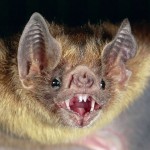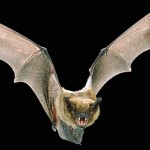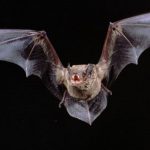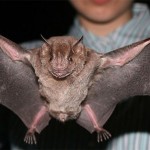These lightweight creatures are incredibly adaptable, with the bumblebee bat being recognized as the smallest mammal in the world. Their ability to thrive in various habitats highlights their remarkable versatility and resilience.
Bat Facts :
Bat is the only mammal that is capable of flying. The bat’s feather-like body and lightweight build enable it to fly effortlessly. Additionally, bats possess an exceptionally acute sense of hearing. It can hear any small sound even from the distance of 6 miles long.
They use the echolocation method for identifying its prey. It emits a sound that reaches the object (prey) and bounce back. A bat can accurately gauge the distance and speed of its prey even while in flight. It all takes less than a second for a bat to recognize its prey.
Bats feed on tons of insects each day thus helping in pest control. Bats are capable of flying in great heights. Bats can live up to 30 years, giving them one of the longest lifespans among mammals. Most bat species are carnivorous, feeding on insects, frogs, and fruit. Only a few species consume blood from other animals. Bats have an impressive digestive system, capable of processing almost any type of food in just 20 minutes.
Some bats are very small, with a wingspan of less than 2 cm, while other species have large wings that can extend over 2 meters. Most bats lack the ability to produce vitamin C from their diet, which may be due to genetic factors.
Diet :
More than half of the species are carnivores feeding on small insects and rodents. As mentioned earlier, they eat thousands of insects every hour, contributing to a cleaner environment. They are fond of birds, lizards and prey on small mammals like rats. They could spot the insects from far-off places. It’s no exaggeration to say that without bats, insects would be overwhelming in number. Their favorite food is mice and insects.
One could not see the bat catching an insect and feeding on it, however minute he may watch. The bat quickly detects insects from high altitudes, captures them with its tail membrane, and feeds on them within moments.
It can capture thousands of flying insects mid-air with remarkable precision and speed. Bats are highly adept at detecting the sounds of frogs in the water, locating them in seconds. Some species use echolocation to capture small fish that disturb the water’s surface.
Some bats exclusively consume fruits and nectar. Only three species, known as vampire bats, have a diet of blood. These bats primarily feed on large mammals by sucking blood from their wounds or injuries. The dung of bat is called guano is largely used as nutrients for soil by farmers.
Habitat :
Bat can live in all zones and places of world. It adapts to the surrounding environment by choosing the diet and right climate for its survival. It is considered to be the most widely seen mammal in all continents of the world except for freezing zones and Polar Regions.
They select different habitat depending on the season. They spend most of the day hibernating in roosts such as trees, crevices, and man-made holes, and begin hunting at night. There are millions of bats in some of its species and few species are becoming extinct now.
Behavior :
Bats have the rare quality of sensing its prey using sounds. It is known as echolocation which is a process in which they emit sound which gets bounced back when it hits an object. Bats can sense the direction and exact location of the object (whether it is animal, bird or insect) and even its size in just fraction of second using this principle.
Most species live in groups or colonies, leading to thousands or even millions of bats occupying caves and dense trees. Some bat species prefer a solitary lifestyle, living alone rather than in groups. To escape the cold of winter, bats may migrate or enter a state of torpor, which can last from a few hours to several months. They are capable of traveling thousands of kilometers to find a more hospitable environment.
Bats do not fly in rain since they cannot use echolocation for hunting its prey since the sound of rain will interfere with the sound emitted by them. Apart from echolocation they also make special sound which is connected with their behavior. Bats are meticulous groomers, similar to teenagers. They spend hours cleaning and licking themselves, as well as grooming others within their group.
Predators :
The main enemies of bat are hawks, eagle, large snakes and falcons. Certain large spiders can capture and consume bats that get entangled in their webs.
Lifestyle :
Most of the bats are nocturnal (active in night) and they are capable of sensing its prey from any distance. These are the smallest mammals capable of flying any distances at great heights. They generally live in colonies in the caves, forests and trees and choose their destination after ascertaining the availability of food.
Lifecycle :
Bats are capable of flying 25 miles per hour and are at par with many birds. As mammals, bat mothers care for their young until they are able to fly and find food on their own. Most of them are black or brown in color but there are few species in white color.
Breeding :
Bats (unlike other mammals) yield only one pup during a year. The gestation period for bats varies significantly with size. Smaller bats may have a gestation of as little as 40 days, while larger species can be pregnant for up to 6 months.
Bats are among the slowest mammals when it comes to reproduction. The birth weight of a pup can be up to 25% of the mother’s weight. Female bats typically establish maternity colonies to care for and nurture their young, while males usually do not assist in raising the pups.
Breeding seasons is normally spring or in warm climatic condition. It would first check for abundant food supplies before building the maternity colony and mating. Some female bats will have 2-3 litters in a year however they yield only one pup for a year.
It is really difficult for the mother to carry their young ones while flying. The pup will feed on the milk of the mother which has to depend on plenty of insects to prevent starving of the self and young one. The young ones can become fully mature and independent ranging from 6 weeks to 4 months, depending on its size. Females will mate with their partners only when conditions are favorable and food is abundant.
It is very surprising to note that females will not release the sperm to fuse with eggs until the spring comes. Unlike other species fertilization do not take place immediately after mating. All these efforts are taken care of by the female bats for the ultimate survival of its young one without any hazard.
Appearance :
Bats are mammals ranging from the smallest size (less than 2 cm) to 180 cm in length. According to their size their weight varies from 2 gm to 1000 gm. They are small black creatures looking similar to that of mice. It can spread its wings while in flight. Bats belong to the order of Chiroptera and his forelimbs are modified into webbed wings. It is the only mammal that can achieve true flight, capable of covering any distance.
It has an excellent sense of smell which it uses to locate foods and finding roosts. Bats which eat fruits and nectar have increased sense of smell for identifying new variety of plants. The belief that bats are blind is a myth. They have small blackish brown eyes and have clear eyesight.
Their eyes are capable of locating objects clearer in the dark than during the day. They have a pair of strong feet that allow them to hang upside down from their roosts. It uses the membrane of its body to make upward and downward movements. Its forelimbs are in the form of wings and there is “lift” like feature between the 4th finger and 5th finger.
Images, Pics, Photos and Pictures of Bat :
Life Span :
Life span of a bat is more than many mammals in the world. A bat can live up to 30-35 years. It’s noteworthy that despite its small size, it can live a remarkably long time, a feat not possible for many small mammals. White nose syndrome is a type of fungus that attacks and kills several species of bats deteriorating its population.
Bats At a Glance :
- Bats are the only mammals capable of flying long distance.
- Bats are nocturnal in habit and live in almost all places of the planet.
- They account for almost one quarter of the entire mammal population in the world.
- They help in pest control by eating thousands of insects every hour.
- Bats have the highest life span among mammals living for 30 years.














